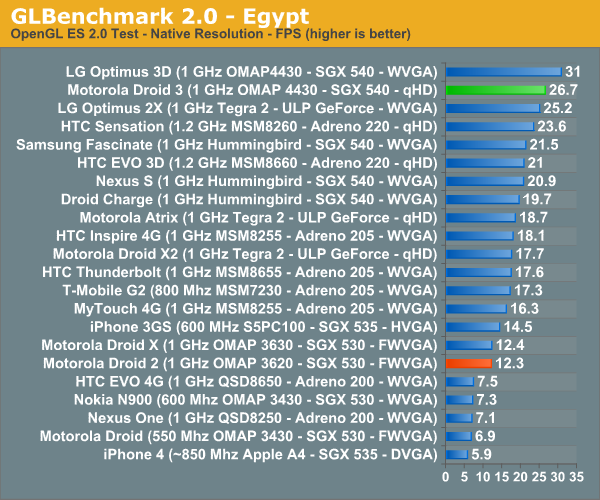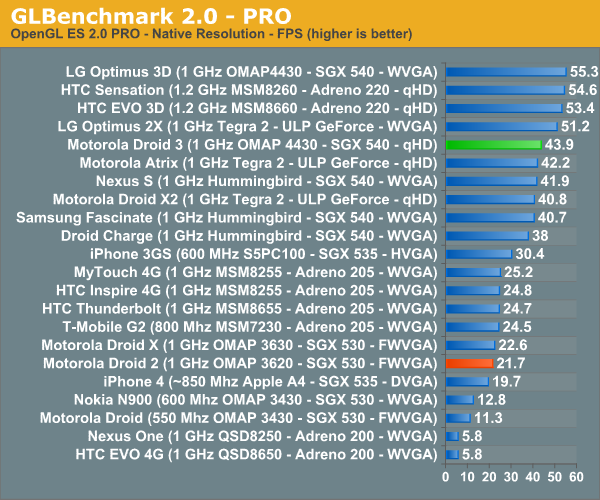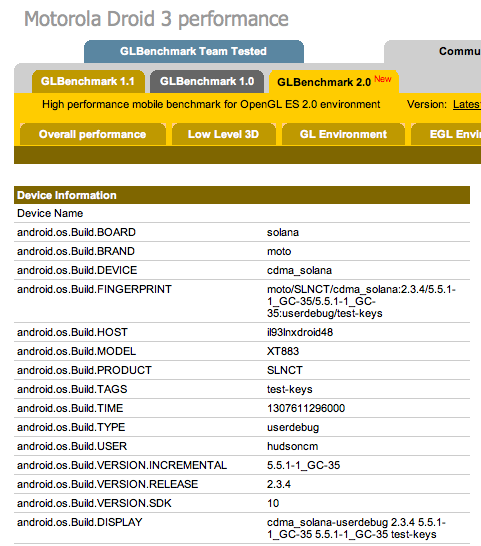Motorola Droid 3 Pops up in GLBenchmark - A Verizon XT883 with OMAP4
by Brian Klug on June 20, 2011 4:27 PM ESTA tipster dropped a link our way early this morning to a GLBenchmark 2.0 results browser page that might be of interest to many. Hit that page and you'll find a complete run of the current GLBenchmark 2.0 suite, and a bit of a confirmation about what is and isn't the upcoming Motorola Droid 3. It isn't Tegra 2, it's OMAP 4430.
First off, the hardware specifications that we can glean from the information page seem to make it a virtually identical match with the specs of the Motorola Milestone 3, or XT883. That means a qHD 960x540 display likely 4" in size, hardware five-row QWERTY keyboard, Android 2.3.4, a possible 1 GB of LPDDR2 (512 MB is the other less-desirable, rumored number), 8 MP rear camera, front camera, and of course an accompanying CDMA2000 baseband for Verizon.
Given the number of recent flagship Motorola product launches with Tegra 2 SoCs, starting with the Motorola Atrix, the Droid X2, and the now-delayed Droid Bionic it seemed that a flagship (read: QWERTY keyboard-packing) summer Motorola Droid launch with Tegra 2 was inevitable. From the results page, it now seems that the Motorola Droid 3 will include a 1GHz OMAP 4430 SoC with PowerVR SGX 540 graphics, and not a Tegra 2.
The model in the results browser is codenamed "Solana" which matches the codename we've heard about for the Verizon-bound Motorola Droid 3. The photos below are of the XT883 which the Motorola Droid 3 will undoubtedly bear an uncanny resemblance to.
Motorola Milestone 3 - XT883 for China (courtesy: Motorola Mobility)
The benchmarks themselves paint an interesting picture, and while we're at it I've tossed in some other devices we have in-hand but haven't finished our full reviews of yet for comparison with these results from the Motorola Droid 3. Again GLBenchmark 2.0 runs we're reporting here are at native resolution for the respective devices, which we've now included in the description line for comparison. For a quick refresher, WVGA is 800x480, FWVGA is 854x480, and qHD is 960x540.


I've highlighted the previous Motorola Droid 2 results (which we reviewed last year) just for fun to illustrate how far we've come in one calendar year.
The Motorola Droid 3 results are impressive, edging out the Adreno 220-packing HTC Sensation and EVO 3D in the more demanding Egypt test, but not quite in Pro. No doubt this is thanks at least partially to the newer Imagination drivers which give a small performance boost.


















42 Comments
View All Comments
ph00ny - Wednesday, June 22, 2011 - link
Send me a list of benchmark scores you would like to see and i will run it on my stock unrooted sgs iiPete_ - Monday, June 20, 2011 - link
Darn -- I was really hoping I'd see something that may give doubt to the half-gigabyte spec. we've been seeing. Although at the higher frequency (333/233 vs. 133 of Tegra 2), it may still be worthwhile to send back my current unit (a Droid X2) in favor of a Droid 3. I miss the physical keyboard I had on my OG Droid something fierce.Thanks for keeping us updated. If you do hear anything about hard specs. on this phone, I and others would love to know.
Pete_ - Monday, June 20, 2011 - link
Oops *333/266 I mean.Pete_ - Monday, June 20, 2011 - link
It's curious to see the comparison against the EVO 3D. The pro version clearly benches far above the Droid 3 yet the regular version benches under it. Very odd.iamlilysdad - Monday, June 20, 2011 - link
Different sets of instructions are supported by different chipsets. Tegra, for example, notable has no support for NEON instructions, which hinders it's performance significantly in certain applications/benchmarks.The flipside is that certain games aren't able to run on Galaxy S II devices because of lack of support for specific sets of instructions. This will have to be remedied by the dev, because for Samsung would need to implement a hardware change.
It's sad, really, to see the type of hardware fragmentation that we're seeing happen in terms of Android SoC's and what they can/can't do.
LetsGo - Tuesday, June 21, 2011 - link
Hardware fragmentation is good, more competition in the GPU space.Also if you have a rooted device you can always install Chainfire 3D for maximum compatibility :).
ph00ny - Wednesday, June 22, 2011 - link
Why do manufacturers need to implement changes when game devs are not utilizing standard OpenGL? Whole tegra optimized comes from utilizing Nvidia specific texture compression method. Also devs like chainfire have remedied this as much as possible by creating an app to act as an intermediate driver and translate nvidia specific instructions to standard OpenGLmetafor - Monday, June 20, 2011 - link
The two benchmarks use different scenes. GPU's, like CPU's are a lot more complex than a simple number can represent. Different scenes or game engines will hit different strengths and weaknesses of a GPU. If the scene is texture-heavy (outdoor scenes with a lot of sky, etc), then GPU's with a high pixel shader/texture pipeline will do better. Whereas if a scene is fragment or object-heavy, then GPU's with a lot of vertex performance will win out.GLBenchmark's Egypt also uses a lot of advanced OpenGL features that Pro doesn't. So for any given GPU design/driver, it may hit certain weaknesses in OpenGL command interpreting that doesn't perform well.
fortelv999 - Monday, June 20, 2011 - link
I understand that it may not be so important but i think it's interesting to see the 4 ULP Geforce cores of the Tegra2 getting beat down by a year old GPU...Of course i don't know the detail about the implementation done by TI on this particular SoC... i know it runs at a higher clock than on the Galaxy S, but is it still one core? If so, how would it compare to the SGX542MP used on the iPad2(possibly iPhone5)?
metafor - Monday, June 20, 2011 - link
Well, GLBenchmark on the iPad 2 has been tested by this very site and the results were at least 2-3x the performance of any of these phones at the iPad 2's resolution (1024x768). So the SGX543MP2 (I assume that's what you meant) is a beast.Of course, looking at the size of the A5 chip, it very well should be.